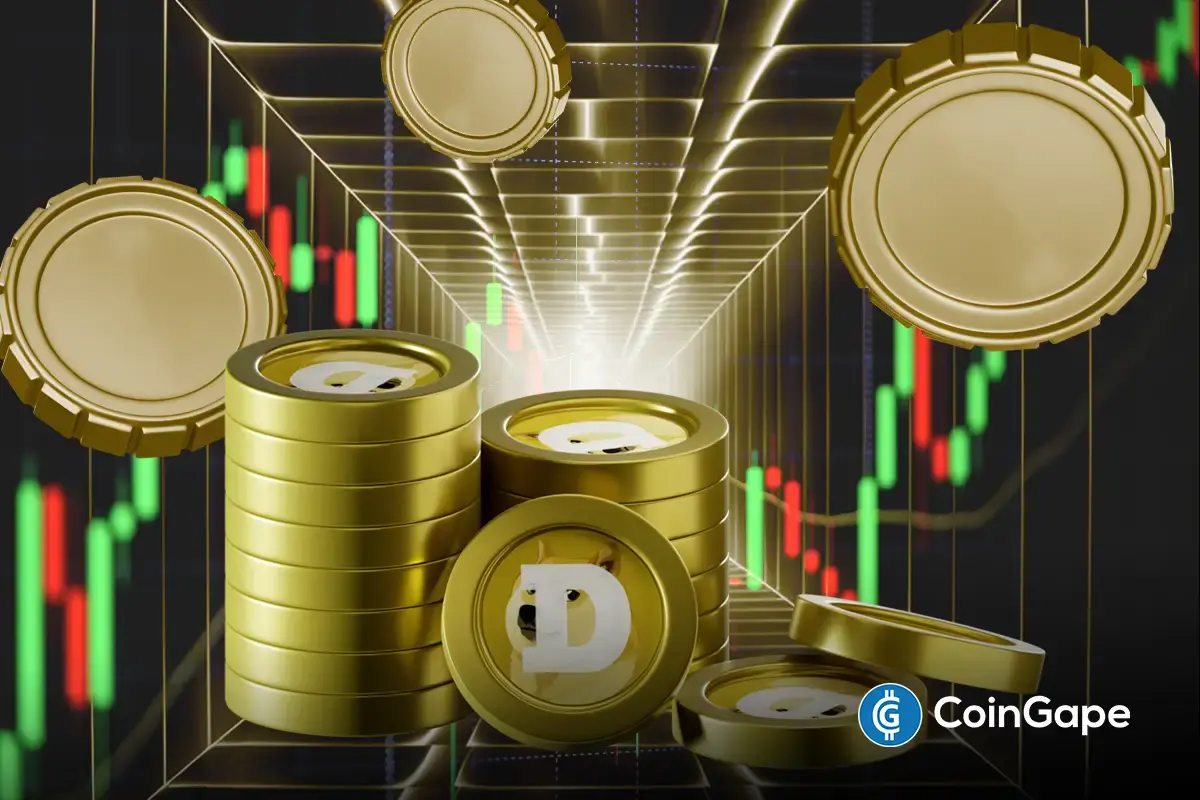Market
This Is Why SUI Price May Not Form a New ATH

SUI price has been experiencing an upward trend recently, making it a potential contender for reaching a new all-time high (ATH). However, shifting investor sentiment suggests that the altcoin may struggle to achieve this milestone.
Despite its recent gains, SUI’s momentum appears to be faltering as technical indicators show signs of an upcoming market shift.
SUI Gains Unlikely
One of the main concerns for SUI’s price action is the tightening of the Bollinger Bands, which signals an impending volatility squeeze. A squeeze occurs when the Bollinger Bands narrow, typically followed by a sharp price movement, either up or down. The significant drop in trading volume further confirms that a squeeze is likely approaching.
This upcoming squeeze could lead to heightened volatility for SUI, and while there is a possibility for a rally, it could just as easily result in a price drop. The lack of volume shows that investor activity is waning, which may mean a lack of sufficient support for pushing the altcoin to a new ATH.
Read More: Everything You Need to Know About the Sui Blockchain
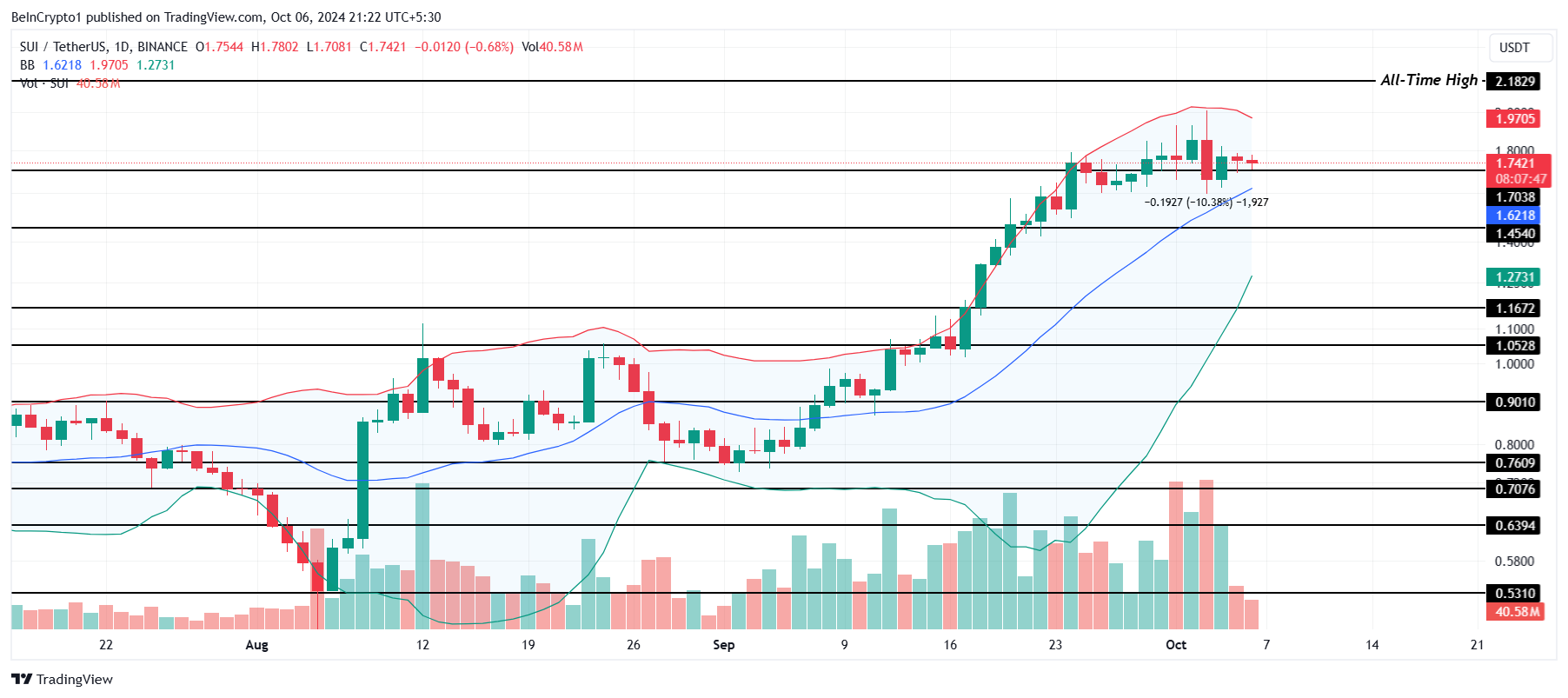
SUI’s macro momentum also presents some concerns. The moving Average Convergence Divergence (MACD) indicator is showing early signs of a bearish crossover, a pattern that typically signals a trend reversal towards the downside. This is particularly notable because it would be the first bearish MACD crossover in nearly a month for SUI, suggesting that the volatility from the squeeze might favor the bears.
With this bearish crossover, it becomes more likely that SUI’s price will face pressure to decline. This adds weight to the argument that SUI may not be ready to form a new ATH in the near term. The confluence of technical indicators is hinting at a potential reversal that investors should be cautious of.
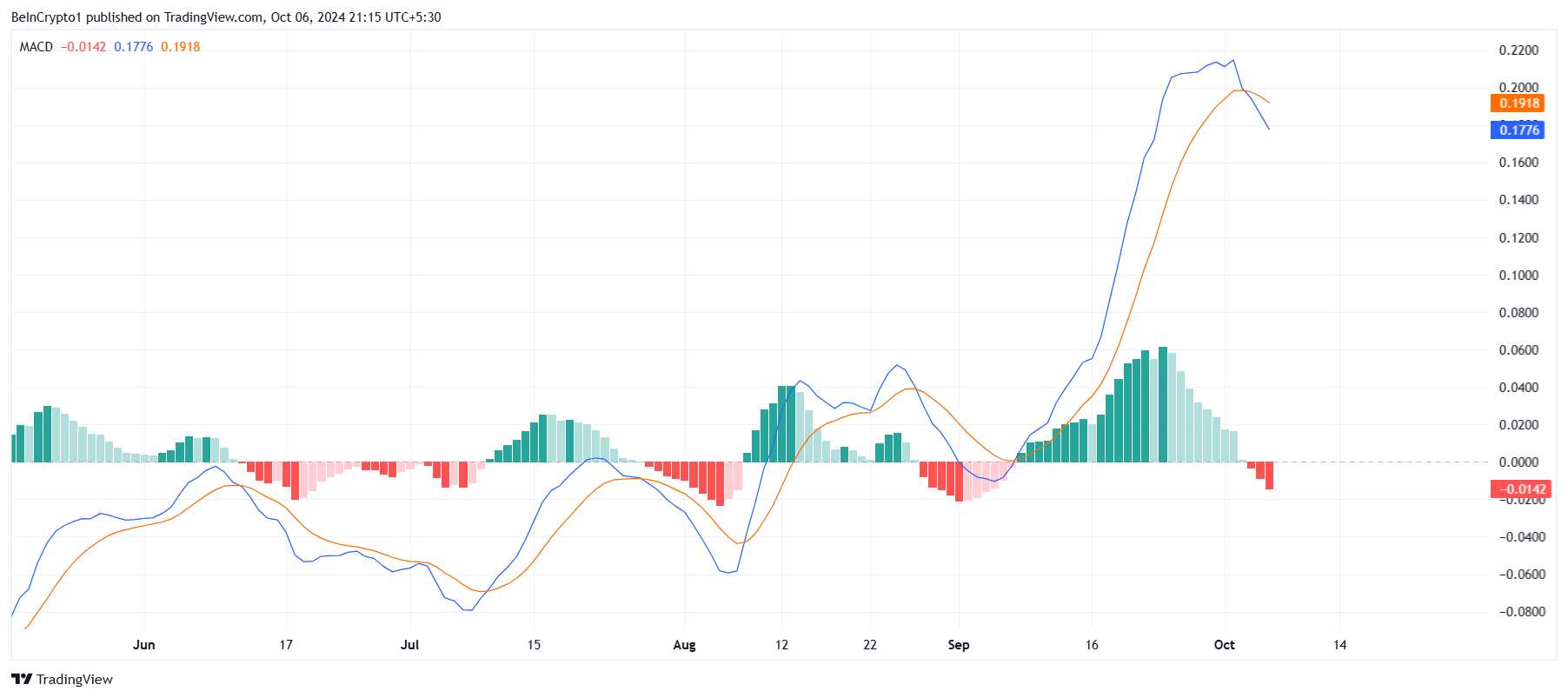
SUI Price Prediction: Loss Ahead
SUI’s price is currently hovering at $1.74, just above the critical support level of $1.70. If the support is lost, the altcoin could fall further, leading to a larger price drop.
Given the current technical indicators, a decline to $1.45 is plausible, and if investors start selling, this drawdown could extend to $1.16. Such a move would further diminish the chances of SUI hitting a new ATH anytime soon.
Read More: A Guide to the 10 Best Sui (SUI) Wallets in 2024
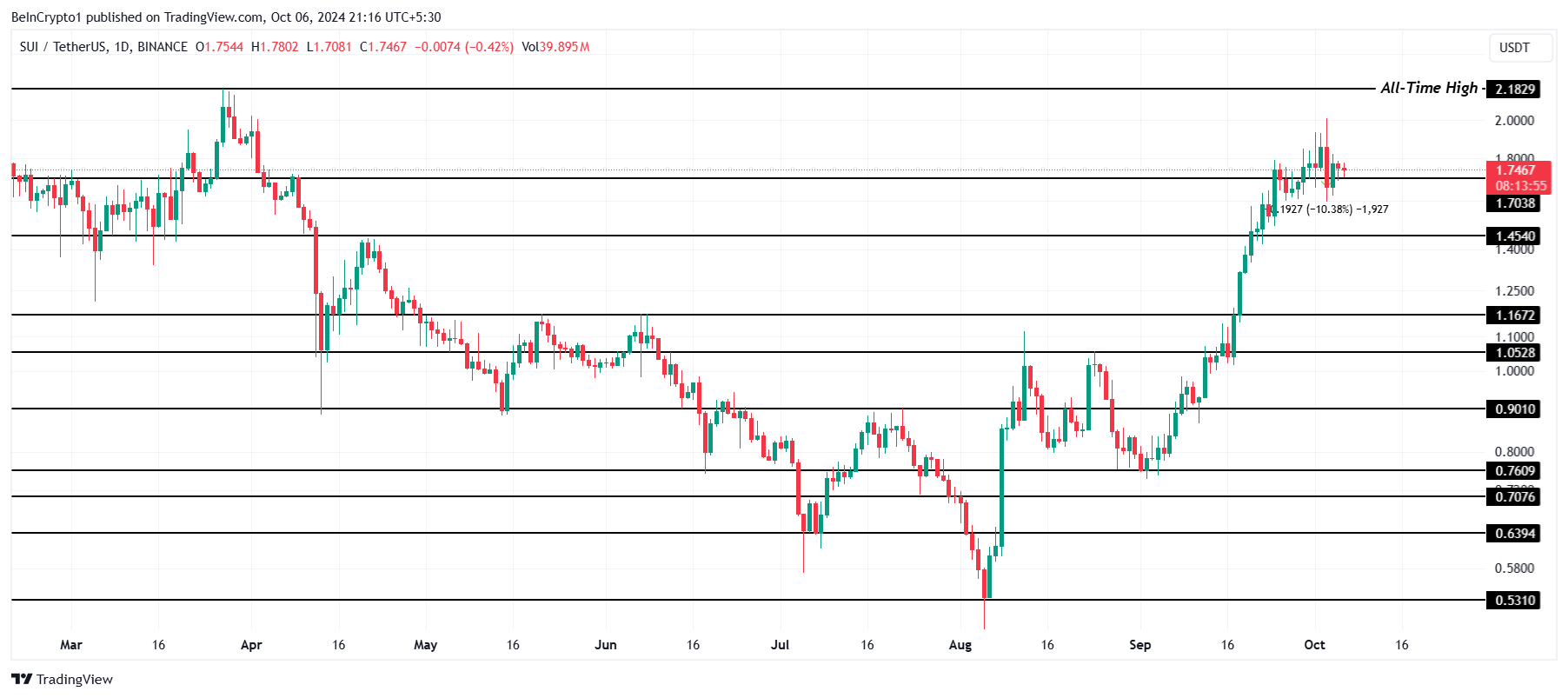
However, if the broader market shows bullish strength and manages to overpower the current bearish sentiment, SUI could rise to $2.18. Breaching this level would invalidate the bearish outlook and set the stage for SUI to form a new all-time high.
Disclaimer
In line with the Trust Project guidelines, this price analysis article is for informational purposes only and should not be considered financial or investment advice. BeInCrypto is committed to accurate, unbiased reporting, but market conditions are subject to change without notice. Always conduct your own research and consult with a professional before making any financial decisions. Please note that our Terms and Conditions, Privacy Policy, and Disclaimers have been updated.
Market
Investors Shift to Crypto, Gold, and Equities Amid Tariff Volatility

Welcome to the US Morning Crypto Briefing—your essential rundown of the most important developments in crypto for the day ahead.
Grab a coffee to see how investors in emerging markets are doubling down on digital assets and tokenized alternatives as the US dollar falters and inflation risks rise.
Investors Turn To Crypto, Gold Amid Imminent Challenging Economy for the US
Escalated trade war chaos and abounding recession concerns, these narratives have put the status of the US as a haven in question while exacerbating volatility in financial markets.
Now, headlines in Washington are focused on escalating trade tensions, making US crypto news a key market driver. According to Raafi Housain, CEO of digital asset platform Fasset, trading volume has surged internationally for particular assets.
“While US tariff headlines have dominated the macro conversation, in emerging markets we’re seeing a more nuanced response. In countries like Indonesia and Pakistan, trading activity on Fasset has more than doubled this week — partly as users return from Eid, but also due to growing demand for assets that feel resilient amid uncertainty,” Housain told BeInCrypto.
This suggests that perceptive investors are rethinking their strategies and repurposing their portfolios. Specifically, they are looking to new avenues, such as emerging markets, where access to traditional assets has historically been limited.
“Crypto is leading that surge, but we’re also seeing increased appetite for tokenized gold and, interestingly, US equities,” he added.
This portfolio diversification effort is unsurprising, considering US President Donald Trump’s tariff agenda is triggering global market volatility.
Already, macroeconomic signals are darkening despite the Federal Reserve’s (Fed) current inflation figures not fully reflecting the impact of ongoing tariffs.
Economists are sounding the alarm, with Moody’s Analytics chief economist Mark Zandi warning of inflationary pressures by summer.
“…inflation statistics will look pretty ugly by mid-summer if the current trade policies remain in place,” Zandi stated.
Zandi did not rule out the possibility of a recession, with his sentiment coming despite President Donald Trump’s 90-day pause on all reciprocal tariffs, but for China.
This warning aligns with China’s assertion that retaliatory tariffs on US goods lack competitiveness under current tariffs. Recognizing that tariffs are effectively a tax on imports paid by US businesses, Zandi added that these costs are usually passed on to consumers.
Meanwhile, as the investment scope shifts for well-informed investors, Housain notes adaptation, not panic.
“It’s clear that investors in high-growth markets aren’t retreating; they’re recalibrating — seeking diversification and more control in an unpredictable environment,” Housain explained.
Elsewhere, the dollar index (DXY) is dipping against a progressively rising cost of goods. Against this backdrop, crypto, tokenized commodities, and digital access to US equities are the hedges of choice for now.
Chart of the Day
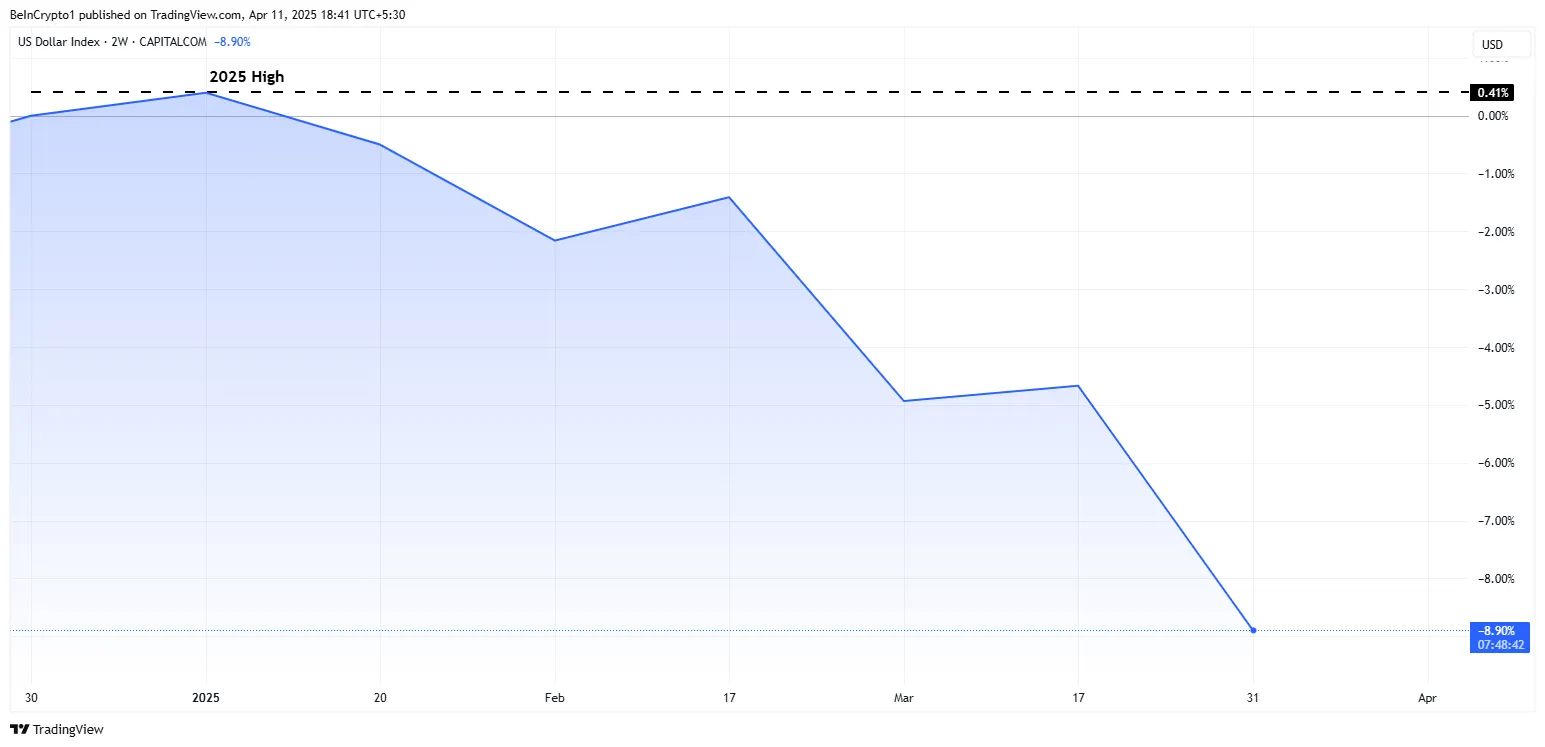
Data on TradingView shows the DXY is down by nearly 10% year-to-date (YTD), from the January 13 intra-day high of $109.87 to $99.04 as of this writing.
Byte-Sized Alpha
Crypto Equities Pre-Market Overview
| Company | Market open |
| Strategy (MSTR) | $284.26 (+5.98%) |
| Coinbase Global (COIN): | $171.09 (+1.22%) |
| Galaxy Digital Holdings (GLXY) | $14.29 (+3.97%) |
| MARA Holdings (MARA) | $11.94 (+7.10%) |
| Riot Platforms (RIOT) | $6.85 (+4.41%) |
| Core Scientific (CORZ) | $6.75 (1.91%) |
Disclaimer
In adherence to the Trust Project guidelines, BeInCrypto is committed to unbiased, transparent reporting. This news article aims to provide accurate, timely information. However, readers are advised to verify facts independently and consult with a professional before making any decisions based on this content. Please note that our Terms and Conditions, Privacy Policy, and Disclaimers have been updated.
Market
How You Can Find Altcoin Winners Early

The crypto market’s “altcoin season” isn’t what it used to be. In past cycles, Bitcoin rallies gave way to altcoin booms, lifting almost every token. Now, new market trends suggest those days of indiscriminate gains are fading.
Analysts predict a more selective altcoin cycle – “the era of everything pumping is over.” In an interview with BeInCrypto, Hitesh Malviya, the founder of the crypto analytical tool DYOR, said that retail investors looking for the next big winner must adapt to these evolving trends.
How to Find Winning Altcoins Amidst Choppy Markets
Traditionally, altcoin season meant Bitcoin’s dominance fell, and most altcoins surged. That broad rally may be ending.
“If the idea of a full-blown alt season comes from past cycles, then that’s something I really don’t expect. What we have seen so far in altcoins was simply the blooming and bursting of a bubble that happened over two bull cycles and two bear cycles,” Malviya told BeInCrypto.
Market experts foresee a more nuanced phase where only the strongest projects thrive. In short, instead of a rising tide lifting all boats, the next altcoin season may favor quality (projects with real usage and revenue) over quantity.
Investors should focus on fundamentals like usage, revenue, and community growth—the market now rewards substance over hype. Indeed, interest in speculative sectors such as meme coins has drastically declined since late January 2025.
“The adoption curve will take a new shape upwards, while the speculative curve will lose its charm, introducing lower volatility in the market, providing more stable returns, and making the market less correlated to stocks. This will create a new asset class in crypto, which should have two major types of asset offerings—tokenized equities with strong cash flow (e.g., AAVE) and store-of-value assets (BTC, ETH),” Malviya continued.

A key reason for the evolution of the altcoin season is that liquidity now rotates between different narratives.
Liquidity flows toward compelling stories. There have been mini-cycles where certain themes catch fire – meme coins, AI tokens, DeFi projects, metaverse gaming, etc. Money chases one hot narrative, then moves to the next.
Savvy investors watch social media, developer activity, and news to catch emerging narratives early and get in before the crowd.
“Liquidity will always flow into different narratives at different times, as there are multiple categories within crypto—just like in stocks, where some categories always outperform others. The same market dynamics will be seen in crypto as well,” Malviya stated.
How to Find Potential Altcoin Season Winner? Identifying Strength in Downtrends
Malviya believes that investors should watch for altcoins showing relative strength during downturns. If an altcoin can hold its value or even rise while Bitcoin slides, that resilience signals strong demand (likely early accumulation).
“At DYOR, we offer a metric called Optimised Relative Strength, which helps track some of the best coins and narratives that have shown the highest strength in the past 7, 30 and 90 days. Coins that have outperformed against the broader market in the past 30 days have a great chance of rallying when the market finds a bottom and starts a fresh leg up,” Malviya explained.

Moreover, Malviya also discussed other fundamental metrics to track. These include:
- DEX Volume: Rising trading volumes on decentralized exchanges can push the native token’s prices higher.
- Total Value Locked (TVL): Growth in deposits and total value locked implies user trust – bullish for the lending protocol’s token.
- Derivatives Volume: Increasing on-chain trading activity means more traders and fees supporting its token.
- Oracle Total Value Secured (TVS): Climbing total value secured by an oracle (e.g., Chainlink) shows a greater reliance on it, boosting token demand.
- DePIN Revenue: Actual revenue from a DePIN project (real-world service) signals a sustainable model, not just hype.
Furthermore, Malviya also emphasized the tokenomics of a crypto project. He believes that even a great project can falter if its tokenomics are flawed.
Tokenomics – a token’s supply and incentive design can make or break an altcoin. Good tokenomics (fair distribution, strong utility) create lasting demand, whereas poor tokenomics (excessive inflation or constant insider unlocks) often doom a project.
“Ideally, the community and ecosystem fund should get at least 60% of the supply to generate actual demand for the product by incentivizing developers and users through planned token emissions at different stages. Tokens are actually created to drive real user demand for the product. They can be considered as bribes to get user attention, but since these bribes are also tradable in the market, they can create a ripple effect that could potentially lead to the product’s failure. This happens because retail sentiment often mixes both the product and the token, where, in most cases, the token price eventually determines how much adoption the product gets,” Malviya elaborated.
Lastly, he shares tools that can help users potentially find the next winner for the altcoin season.
- DYOR – Users can use DYOR to find relative strength data on more than 200+ coins, detailed demand-side tokenomics data on 70+ coins, and fundamental data on 65+ coins, along with detailed research reports on top projects.
- DeFiLlama – It tracks multi-chain DeFi data like TVL and volumes.
- Dune Analytics – It is a community-driven platform offering custom on-chain data dashboards.
“The community should learn to use DeFiLlama and DUNE dashboards to uncover some interesting alphas. Most on-chain data is tracked on both of these platforms—all you need to do is find the right dashboard, take notes of the different growth metrics you notice, and build your thesis around a coin using that data to reach better due diligence,” Malviya concluded.
Those armed with solid research stand the best chance of catching the next altcoin season winner.
Disclaimer
In adherence to the Trust Project guidelines, BeInCrypto is committed to unbiased, transparent reporting. This news article aims to provide accurate, timely information. However, readers are advised to verify facts independently and consult with a professional before making any decisions based on this content. Please note that our Terms and Conditions, Privacy Policy, and Disclaimers have been updated.
Market
Binance, Trade Wars, Ripple and SEC

Crypto market volatility was high this week as regulatory developments, macro tensions, and the Binance exchange’s decisions shook markets.
A brewing trade war, whispers of stealth quantitative easing, and a historic legal truce between Ripple and the SEC are reshaping narratives. The following is a roundup of what happened this week in crypto.
Binance Earmarks 14 Altcoins For Delisting
Binance, the largest crypto exchange by trading volume metrics, announced a decision to delist 14 tokens, including BADGER, BAL, and CREAM.
The decision led to double-digit losses for the affected tokens almost immediately, highlighting the effect of such announcements on investor sentiment.
Binance initiated the delisting process through its vote-to-delist mechanism, where the community participated in deciding the fate of certain tokens. Reportedly, out of 103,942 votes from 24,141 participants, 93,680 were deemed valid.
The exchange cited factors such as development activity, trading volume, and liquidity in its evaluation before earmarking the cited altcoins.
“Following the Vote to Delist results and completion of the standard delisting due diligence process, Binance will delist BADGER, BAL, BETA, CREAM, CTXC, ELF, FIRO, HARD, NULS, PROS, SNT, TROY, UFT and VIDT on 2025-04-16,” read the announcement.
Trading for these tokens will cease on April 16, with withdrawal limitations set for June 9. Post this date, any unsold tokens will be converted to stablecoins.
Arthur Hayes: Inevitable Return to Fed Stimulus
This week in crypto, Arthur Hayes returned with a bold thesis. According to the BitMEX co-founder, the unfolding US-China trade war and the inevitable return of Fed stimulus could catapult Bitcoin to $1 million.
Hayes tied Trump’s proposed 125% tariffs on Chinese goods to a broader breakdown in global trade. He also referenced a scenario where the USD/CNY hits 10.00, calling it the “super bazooka” that could propel Bitcoin higher.
According to Hayes, such protectionism will trigger supply chain disruption, inflationary spikes, and, ultimately, a resumption of quantitative easing (QE) as central banks try to stabilize faltering economies.
He sees this monetary pivot as the spark for Bitcoin’s next supercycle.
In a more immediate scenario, the BitMEX executive also argued that if the Fed pivots to QE soon, Bitcoin could hit $250,000 even before a global financial reckoning sets in.
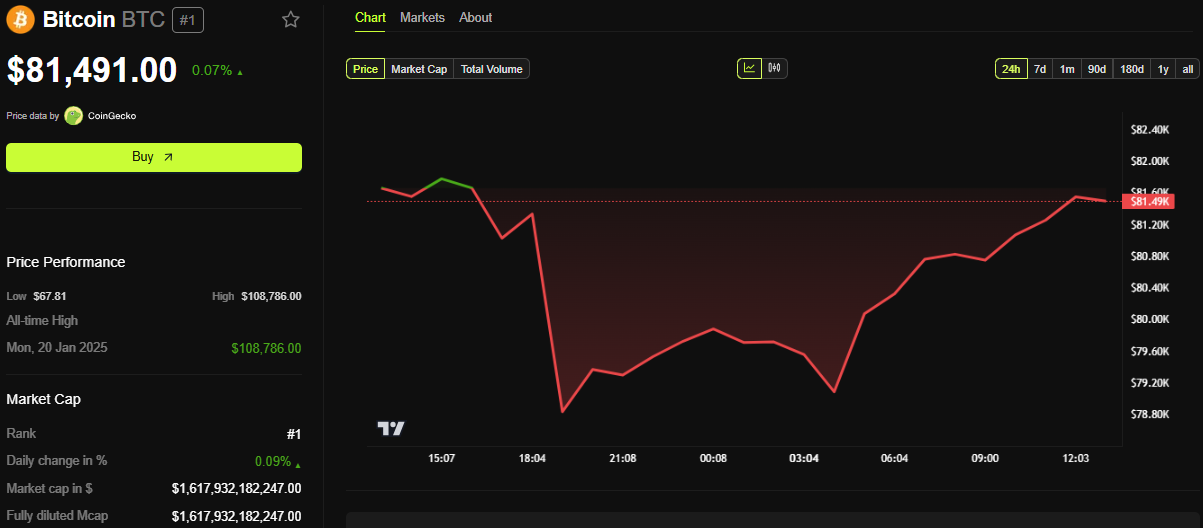
Hayes’s outlook sounds overly ambitious. However, with US liquidity injections already under scrutiny, analysts are increasingly aligning with the idea that macro tailwinds could push Bitcoin far beyond the current $81,000 range.
Is the Fed Already Doing Stealth QE?
BeInCrypto reported this hypothesis this week in crypto. Some analysts are raising red flags about stealth quantitative easing, suggesting the Fed is quietly injecting liquidity into the financial system without formally announcing a new QE program.
“This isn’t hopium. This is actual liquidity being unchained. While people are screaming about tariffs, inflation, and ghost-of-SVB trauma… the biggest stealth easing since 2020 has been underway,” wrote Oz, founder of The Markets Unplugged.
Liquidity metrics such as the Reverse Repo Facility (RRP) hint at significant capital flows, even as the Fed maintains a public anti-inflation stance.
Critics argue that these backdoor injections are fueling asset prices, including crypto, without the transparency or accountability of past QE rounds.
For crypto, stealth QE may be one of the key reasons Bitcoin remains resilient despite calls for significant breakdowns below $70,000.
If confirmed, these quiet interventions could be laying the groundwork for a larger, formal liquidity wave. Such an action would align with Arthur Hayes’s prediction of a new Bitcoin super cycle.
Meanwhile, amid cooling inflation and US growth forecasts softening, the possibility of a formal return to QE in 2025 is gaining traction among economists.
Analysts highlighted that if the Fed pivots to liquidity expansion, Bitcoin and major altcoins could enter a multi-year bull cycle akin to the 2020–2021 rally.
Ripple and SEC File Joint Motion
Another top headline this week in crypto, Ripple and the US SEC (Securities and Exchange Commission) filed a joint motion to settle the remaining remedies phase of their years-long legal battle.
The move signals both parties are ready to wrap up a case that has cast a regulatory shadow over the crypto market since 2020.
“The parties have filed a joint motion to hold the appeal in abeyance based on the parties’ agreement to settle. The settlement is awaiting Commission approval. No brief will be filed on April 16th,” wrote XRP advocate James Filan.
The motion follows Judge Analisa Torres’s 2023 ruling that XRP is not a security when sold to retail investors. This decision marked a partial but critical win for Ripple.
What remains now is a resolution over institutional sales, penalties, and injunctions. According to legal experts, the fact that both Ripple and the SEC are willing to settle suggests neither side wants to prolong the case amid broader legal and political uncertainty.
The resolution will likely influence how the SEC proceeds with other enforcement actions against major crypto firms. For Ripple, regulatory clarity could open the door to US re-listings and deeper integration with traditional finance (TradFi).
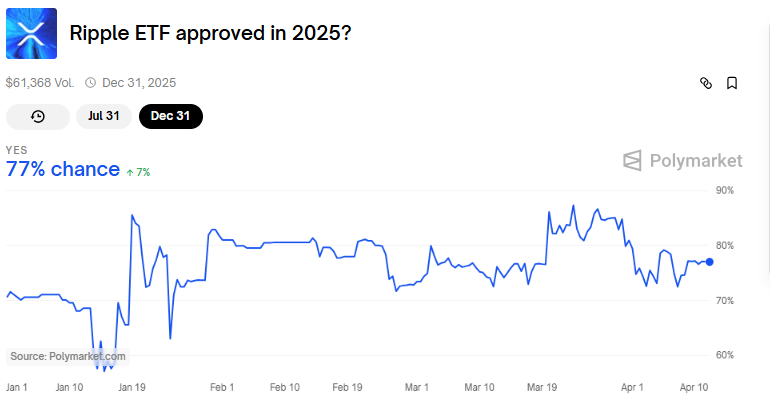
Specifically, it could increase the odds for an XRP ETF (exchange-traded fund) in the US, which now stands at 77%, data on Polymarket shows.
Trump Pauses Tariffs—Except on China
This week in crypto, the crypto market surged over 5% in total capitalization after Donald Trump announced he would pause tariffs on most US trading partners. BeInCrypto reported that China was the only exception.
“Based on the lack of respect that China has shown to the World’s Markets, I am hereby raising the Tariff charged to China by the United States of America to 125%, effective immediately,” Trump shared on Truth Social.
The move reignited risk-on sentiment in markets, particularly crypto, which remains highly sensitive to macro policy shifts.
Analysts interpreted the announcement as a double-edged message. On the one hand, the global economy might get a reprieve from broad-based trade pressure.
On the other hand, China remains a geopolitical target, which could further fragment global trade systems and increase reliance on decentralized assets. In a retaliatory move, China raised tariffs on the US to 125%.
Disclaimer
In adherence to the Trust Project guidelines, BeInCrypto is committed to unbiased, transparent reporting. This news article aims to provide accurate, timely information. However, readers are advised to verify facts independently and consult with a professional before making any decisions based on this content. Please note that our Terms and Conditions, Privacy Policy, and Disclaimers have been updated.
-

 Bitcoin23 hours ago
Bitcoin23 hours agoFlorida Bitcoin Reserve Bill Passes House With Zero Votes Against
-

 Regulation24 hours ago
Regulation24 hours agoCash App’s Block Inc Settles for $40 Million Over AML Failures For Crypto Platform
-

 Market23 hours ago
Market23 hours agoFuser on How Crypto Regulation in Europe is Finally Catching Up
-

 Altcoin23 hours ago
Altcoin23 hours agoDogecoin (DOGE) Reclaims Previous Breakdown, Will This Mark The Bottom?
-

 Market22 hours ago
Market22 hours ago3 Bullish Altcoins Surging After Trump’s Tariff Pause
-

 Market20 hours ago
Market20 hours agoADA Price Surge Signals a Potential Breakout
-

 Bitcoin22 hours ago
Bitcoin22 hours agoThis is Why Hoskinson Thinks Bitcoin Will Hit $250,000 in 2025
-

 Altcoin12 hours ago
Altcoin12 hours agoXRP Price Risks 40% Drop to $1.20 If It Doesn’t Regain This Level


